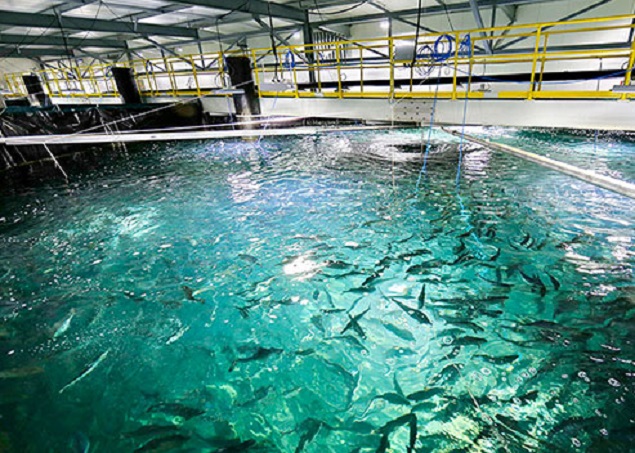
Features
disease management
How-to
Management
Fresh Tips: Biosecurity 101
September 15, 2020 By From the experts at the Freshwater Institute

Pathogens introduced in RAS systems can quickly proliferate, slow fish growth, and inflict heavy losses. All RAS facilities should have biosecurity plans for their farms to help prevent the introduction and spread of pathogens. Every biosecurity plan will be unique but should focus on preventing pathogens from entering, preventing spread in the facility, and reducing the susceptibility of the fish housed on site.
Preventing entry
Preventing pathogens from entering the facility in the first place will prevent an outbreak. Pathogens can enter the facility through source water, on eggs or fish, and through human and vehicle traffic.
Identifying biosecure source water when siting a new facility is ideal. However, the reduced water use of RAS systems can make installing retroactive disinfecting measures, such as UV light, on incoming water viable options to reduce pathogen loads. Additional measures should be taken to protect source waters from wild animals by covering or enclosing.
When stocking your facility with fish, it is preferable to start with eyed eggs from specific pathogen-free certified providers. Another advantage to receiving eyed eggs is that they can be disinfected prior to bringing them into the facility. If stocking live fish is unavoidable, the facility should have quarantine systems, located away from the main production areas, to monitor fish for clinical signs of disease for up to a month before introducing them to the production facility.
Human vectors like vehicles and visitors as well as employees themselves can introduce pathogens. Prevent trucks from approaching main culture buildings by loading with tractors or forklifts from designated loading docks. Disinfect tires and undercarriages of trucks that must approach closely to receive fish. A pump sprayer with disinfectant and handled scrub brush provides simple, even disinfectant coverage. Minimize outsider access to the farm but be prepared for essential visitors. Plan tours far in advance and notify visitors of your biosecurity practices before they arrive, instructing them to wear clean clothing and appropriate footwear that has not been in contact with fish or water from other facilities. Have disposable coveralls and shoe covers handy as an additional protective measure. Staff members should be aware of outside work activities and avoid wearing potentially contaminated clothing or footwear to the facility. Farms should consider providing dedicated boots and wet gear for employees to wear at the farm to minimize risk of pathogen introduction.
Preventing pathogen spread
Preventing the spread of pathogen between areas or systems in the facility can keep disease outbreaks from infecting all the fish on site and reduce the risk of heavy loss across the facility. Responsibility for most prevention measures rest on fish husbandry staff and should be taken seriously.
Ideally, fish at different life stages with different degrees of immunocompetence should be housed in different areas with physical barriers and moved through the facility in an all-in, all-out manner. Likewise, husbandry staff should be dedicated to these areas as much as possible and avoid moving from one area to another each day. When this is not practical, staff should work through daily tasks starting with the most fragile life stages, moving toward more robust fish (starting in the nursery and progressing to grow-out). Any systems with known health concerns should be visited at the end of the day after all other areas have been provided for and employees should wash in and wash out. When moving from one area to another, employees should change their boots and gear, step through disinfecting footbaths, and wash or sanitize their hands to reduce the risk of pathogen transfer. Footbath and hand cleaning stations should be regularly checked and refreshed with chemical.
Areas or individual systems should have dedicated equipment including nets and brushes or any other equipment that contacts fish or system water and be disinfected after each use with a disinfectant dip or spray. Create easily accessible storage areas for each system to encourage keeping equipment in dedicated areas. Larger equipment like crowder walls or transfer equipment that must be shared should be cleaned and disinfected between use.
Unthrifty fish or those displaying clinical signs of disease should be culled from the population promptly. Keep common therapeutants on hand to quickly administer treatments before an outbreak gains momentum.
Reducing susceptibility
Even if all pathogens were excluded from the facility, ubiquitous pathogens will be present in culture water. By selecting robust stocks of fish, providing optimal nutrition and culture conditions including good water quality and appropriate stocking densities, and employing gentle handling techniques, fish will be less susceptible to opportunistic infections. This, in turn, will reduce the overall risk of disease spread through the facility and avoid loss of income from reduced growth, morbidity and mortality.
Although every biosecurity plan will be unique, preventative measures will only be as effective as the farm’s commitment to adhering to them. Biosecurity plans should be revisited often and updated to refine techniques and address evolving challenges.
For more information visit, FreshwaterInstitute.org.
Print this page